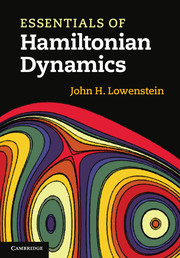5 - Order and chaos in Hamiltonian systems
Published online by Cambridge University Press: 05 June 2012
Summary
In the preceding chapters, we studied integrable systems and their perturbations. We noted that integrability is rare among dynamical systems, and that, while the perturbative approach is quite successful in any finite order, the perturbation series cannot be counted on to converge in the generic case. As we shall soon see, the perturbative convergence problem can be overcome if the perturbation is small enough and certain other hypotheses are satisfied, thanks to the famous theorem of Kolmogorov, Arnol'd, and Moser (KAM) [26, 27, 28]. There are several approaches (none of them easy!) to the statement and proof of this theorem. In this chapter we will rely mainly on that of [28]. A helpful discussion of the theorem, without detailed proofs, can be found in [29].
Perhaps the main message of the KAM theorem is that if we label the invariant n-tori of the unperturbed integrable model by the n oscillation frequencies ω1, …, ωn, and if the perturbation is weak enough, then a fraction, arbitrarily close to unity, of the tori will be preserved. This is the main result concerning “order” in Hamiltonian systems. No comparably strong statement exists concerning what replaces those tori which break up under the perturbation. Here we rely mainly on numerical investigations in a variety of models. These suggest certain universal features, principally island chains and deterministic chaos.
In the present chapter we will introduce the KAM theorem in the context of nonlinear stability of equilibrium states.
- Type
- Chapter
- Information
- Essentials of Hamiltonian Dynamics , pp. 121 - 147Publisher: Cambridge University PressPrint publication year: 2012



